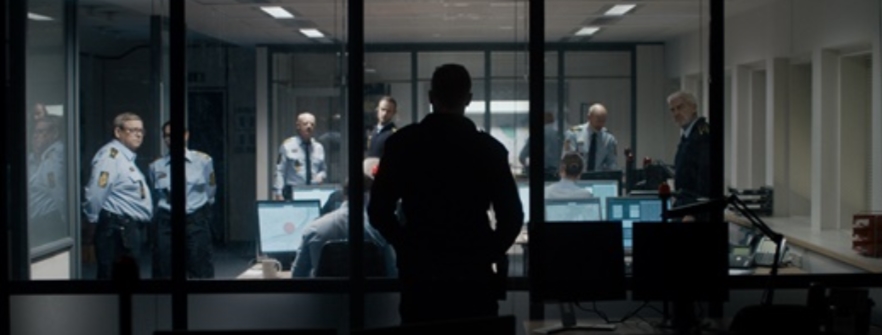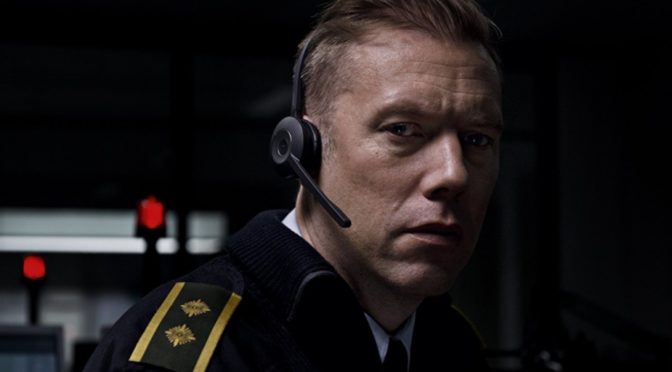Gustav Möller’s Scandi Noir, THE GUILTY, is an accomplished examination of claustrophobia. Set in a single location – an emergency dispatcher’s call room – the film explores the complexities of guilt while simultaneously highlighting the viewer’s own restrictions within the cinema setting.
THE GUILTY opens with police officer, Asger Holm (Jakob Cedergren), demoted to desk work answering emergency service calls. Ager feels suffocated behind his desk; his temporary demotion has left him answering mundane calls, and he craves the excitement of his previous police role.
The noise of telephone ringing, whether that be Asger’s mobile or the emergency calls he receives, punctuates the film. Numerous calls taunt Asger’s boredom with the promise of liberation, but each call always ends in mundanity. When Iben (Jessica Dinnage) calls, we are duped into thinking this is just another hoax caller. However, something keeps Asger on the call and using his police intuition, he asks Iben if she has been abducted, to which she answers yes. Following calls between Asger, Iben, her 6 year old daughter and her supposed kidnapper, the plot follows the twists and turns of the character’s behind the phone calls from the callroom, unravelling details of Asger’s own private life along the way.
The film has no soundtrack other than the loud, high pitched notes of the telephone’s ring. Whether coming from Asger’s mobile or his desk phone, this repeated ringing contributes to the skilful build of suspense. Like Asger, we patiently wait for the phone to ring to feed us with more information. The phone is our only escape from the claustrophobia of the room and subsequently dictates the pace of the narrative.
“We continually are asked to question his motives…”
Asger’s frustration is felt by the audience, mimicked in the claustrophobia of the film itself. While the constant ringing taunts us, and the setting constricts us, the camera is also restrictive. Although this is a film which is full of action, the viewer is kept stagnant, both physically and visually, as the plot unfolds without the typical visual accompaniment. Because of spatial limitations, the camera struggles to move very far from Asger, depriving the viewer of any distance, like the typical establishing shots seen in films. Similarly, we are given an unusually intimate insight into the character’s emotion and movement. Cedergren is masterful in the role, and despite this intimacy of camera, keeps the viewer at enough of a distance that we continue to be intrigued by him and his backstory. We continually are asked to question his motives: is he a skilled police officer motivated by good and limited behind a desk, or is his obsession over the case reflective of a deeper, more complex issue at stake?

As tension in the film builds, Asger moves from the communal call room, to an even smaller and darker side room. We watch as he physically cuts himself off from his co-workers, meticulously closing each of the blinds to the connecting room. In this dimmed space, the red light from his machine glows in the darkness. As the plot begins to climax, it is this same light which envelopes Asger and the room. The moment expertly mirrors the dangers to be found in the red-light district of the city, which were described during one of Asger’s first phone calls of the night. Asger warned the caller, mugged by a prostitute, that such a threat was to be expected. In the call room, the red light takes over the already constricted space, and we are reminded of this earlier conversation. We struggle to see as the camera moves to a close-up of Asger’s face embalmed in his hands. The danger of the so-dubbed red light district is embodied in this room; Möller seems to be encouraging a connection between the dangers which can be found in the two places, in the criminal district and Asger’s current situation. Like Asger’s own previous observations, we remember that everything and everyone is not always what is seems.
The confining space of a cinema is the perfect place to watch this film. Its own restrictions aptly mirror that felt by Asger throughout THE GUILTY. Like Asger, we cannot go outside, we cannot see the faces behind the phone calls, and we cannot investigate further. We can only hope that the phone will continue to ring, and the plot unfold, as we too sit in our seats, gripped by the suspense skilfully crafted by Möller. Restriction and claustrophobia make this film, at points, frustrating to watch, but the ringing of the telephone always arrives at precisely the right moment, and the main plot of the film is complimented by the audience’s discovery of Asger’s own backstory, and admission of guilt.

